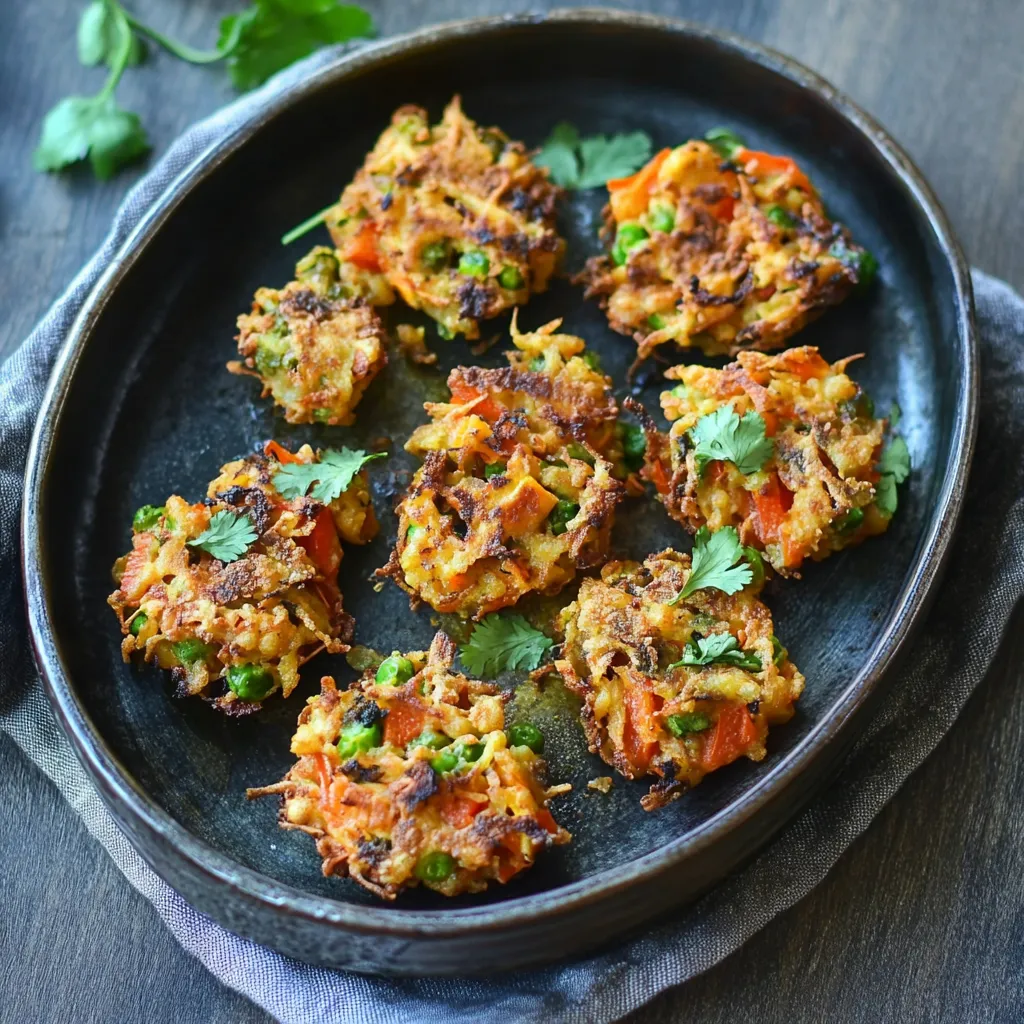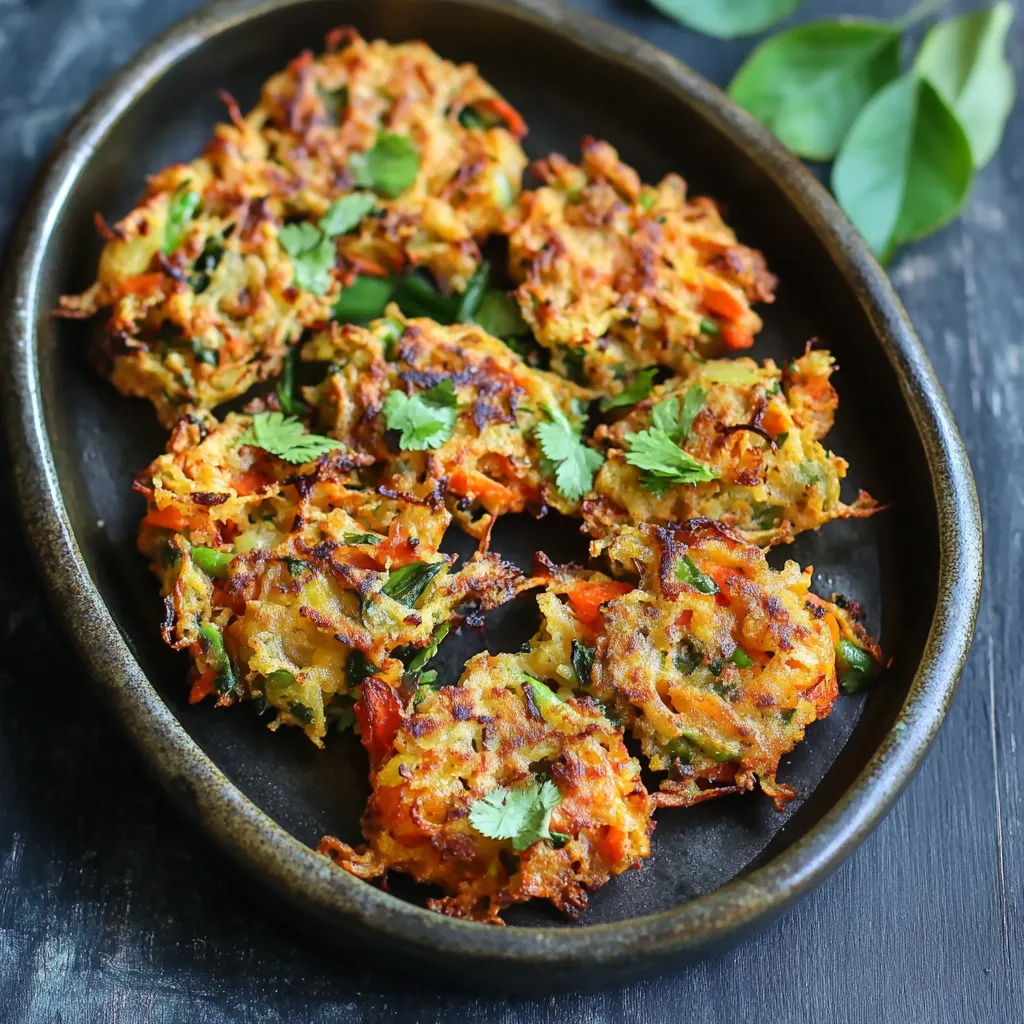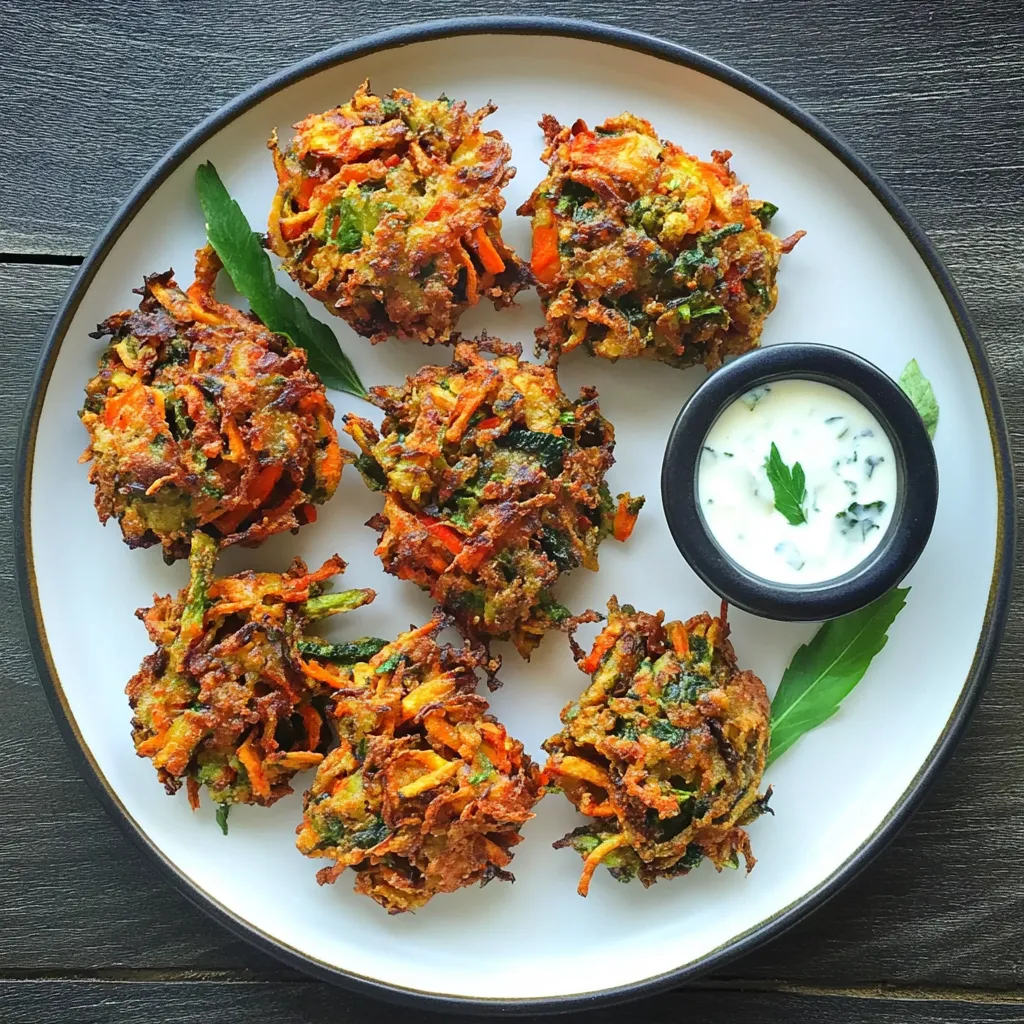 Pin it
Pin it
This quick vegetable pakora recipe transforms humble pantry staples into crispy, golden bites bursting with aromatic Indian spices. The chickpea flour coating creates the perfect crunchy exterior while keeping the vegetable medley tender inside.
I discovered this recipe during a cooking class in Mumbai and have been making it regularly for ten years. My children initially refused to try them until the irresistible aroma finally won them over. Now they help shred the vegetables every time we make them.
Ingredients
- Chopped vegetables: Cabbage, capsicum, onions, carrot and zucchini provide perfect texture contrast and nutrition. Choose the freshest vegetables possible for optimal flavor and crispness.
- Besan flour: Also called chickpea flour, this gives pakoras their distinctive taste and gluten free crunch. Look for fine ground varieties for the smoothest batter.
- Fresh coriander: Adds bright, citrusy notes that balance the earthy spices. Use both leaves and tender stems for maximum flavor.
- Curry leaves: These glossy leaves provide authentic Indian aroma that dried spices cannot replicate. Worth seeking out at specialty markets.
- Fresh ginger and garlic: Essential aromatics that provide the foundation of flavor. Always use fresh rather than pre minced for vibrant taste.
- Green chilli: Adds gentle heat that builds gradually. Adjust quantity based on your spice preference.
- Turmeric: Gives beautiful golden color and earthy flavor. Choose bright yellow powder for freshness.
- Baking powder: Creates slight lift and airiness in the pakoras. Check expiration date for effectiveness.
- Extra virgin olive oil: Healthier frying option that adds subtle fruitiness. Use enough to coat pan generously.
Step-by-Step Instructions
- Prepare vegetables:
- Combine all chopped vegetables in a large bowl and sprinkle with salt. The salt helps draw out excess moisture, ensuring crispy pakoras. Massage vegetables with clean hands, deliberately squeezing to release water. This critical step prevents soggy pakoras and takes about 2 minutes of firm pressing.
- Add aromatics and spices:
- Incorporate coriander, curry leaves, ginger, garlic, chilli, turmeric and black pepper into the vegetable mixture. Each aromatic plays a crucial role in building the complex flavor profile. The curry leaves particularly add an authentic touch that cannot be substituted.
- Create batter:
- Sift chickpea flour and baking powder directly over the vegetable mixture. Using your hand, thoroughly combine until every vegetable piece is coated with flour. The mixture should hold together when pressed without being overly wet. If needed, add extra flour in small increments until proper consistency is achieved.
- Fry pakoras:
- Heat pan over medium heat until fully hot, then add enough oil to generously coat the bottom. Shape small portions of mixture into discs approximately 2 inches wide and 1/2 inch thick. Place carefully into hot oil with space between each pakora to ensure proper crisping.
- Achieve golden perfection:
- Cook pakoras for 3 to 4 minutes undisturbed until deeply golden on bottom side. Flip once and cook additional 3 minutes until second side matches. The pakoras should have crisp edges while maintaining tenderness inside.
- Drain and serve:
- Transfer finished pakoras to paper towel lined plate to absorb excess oil. Serve immediately while still warm for optimal texture and flavor experience.
 Pin it
Pin it
I particularly love the aromatic curry leaves in this recipe. They grow abundantly in my friend's garden in Kerala, and she taught me that slightly crushing them between your fingers before adding releases their essential oils. The first time I made these pakoras with homegrown curry leaves, my kitchen smelled exactly like the street food stalls I remember from traveling through southern India.
Perfect Dipping Sauces
Pakoras come alive with the right accompaniment. Traditional mint chutney pairs perfectly, made by blending fresh mint leaves with yogurt, cumin, and a touch of lemon juice. For a sweeter option, tamarind chutney provides tangy contrast to the savory pakoras. Even a simple combination of yogurt with pinch of cumin and salt creates a cooling dip that balances the warm spices perfectly.
Storage and Reheating
While pakoras are best consumed immediately after cooking, they can be stored in an airtight container in the refrigerator for up to 3 days. To revive their crispiness, place them on a baking sheet in a 180°C oven for 5 to 8 minutes. Avoid microwave reheating as it makes them soggy. The batter mixture itself can be prepared several hours ahead and kept refrigerated until ready to fry.
Vegetable Variations
The beauty of pakoras lies in their versatility. During summer, try corn kernels, thinly sliced bell peppers, and eggplant. Winter versions shine with cauliflower, sweet potato, and spinach. For extra protein, add a handful of soaked and drained mung beans to the mixture. Whatever vegetables you choose, maintain the same overall proportion of vegetables to batter for consistent results.
 Pin it
Pin it
Piping hot pakoras with mint or tamarind chutney are sure to make everyone at the table smile!
Frequently Asked Questions
- → Can I use different vegetables in pakoras?
Yes, pakoras are versatile and can be made with almost any vegetable. While this version uses cabbage, capsicum, onions, carrot and zucchini, you can substitute with cauliflower, potato, spinach, eggplant, or whatever vegetables you have on hand. Just ensure they're chopped finely and squeezed to remove excess moisture.
- → Why do you need to squeeze the vegetables?
Squeezing the vegetables helps release their natural moisture, which is essential for creating the right batter consistency. This technique eliminates the need to add water, resulting in crispier pakoras with concentrated vegetable flavor.
- → What is besan flour and can I substitute it?
Besan flour (chickpea flour) gives pakoras their distinctive flavor and gluten-free binding. While traditional pakoras specifically call for besan, in a pinch you could substitute with gram flour (also chickpea-based) or a mix of all-purpose flour with some cornstarch, though the authentic taste will be affected.
- → Can pakoras be baked instead of fried?
While traditional pakoras are fried, you can bake them as a healthier alternative. Preheat your oven to 400°F (200°C), shape the mixture into patties on a lined baking sheet, spray or brush with oil, and bake for 15-20 minutes, flipping halfway. They won't be as crispy but will still be flavorful.
- → What dipping sauces pair well with pakoras?
Pakoras pair beautifully with mint-coriander chutney, tamarind chutney, or yogurt-based raita. For a simple option, try mixing yogurt with a pinch of salt, cumin, and chopped herbs. Sweet chili sauce or even ketchup can work for a fusion approach.
- → How can I store leftover pakoras?
Store cooled pakoras in an airtight container in the refrigerator for up to 3 days. To reheat, place in a preheated oven at 350°F (180°C) for 5-10 minutes until crisp and heated through. Avoid microwaving as this makes them soggy.
